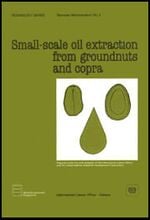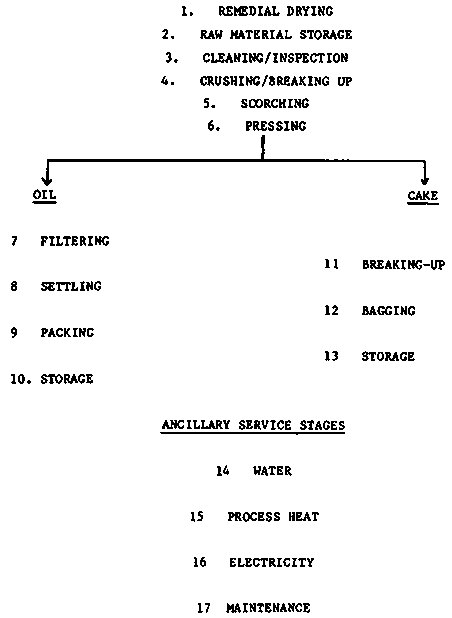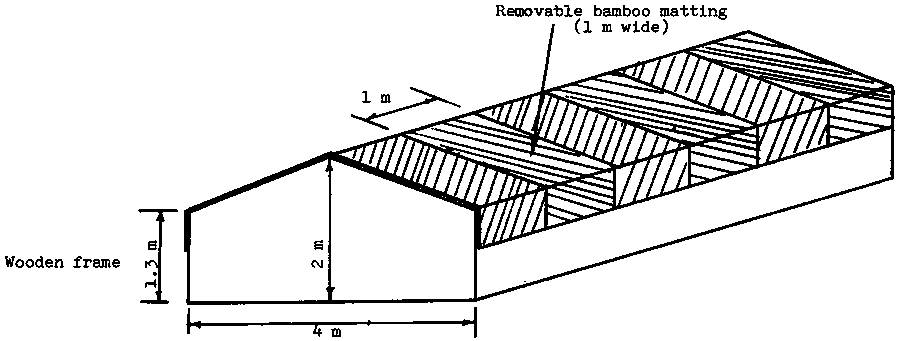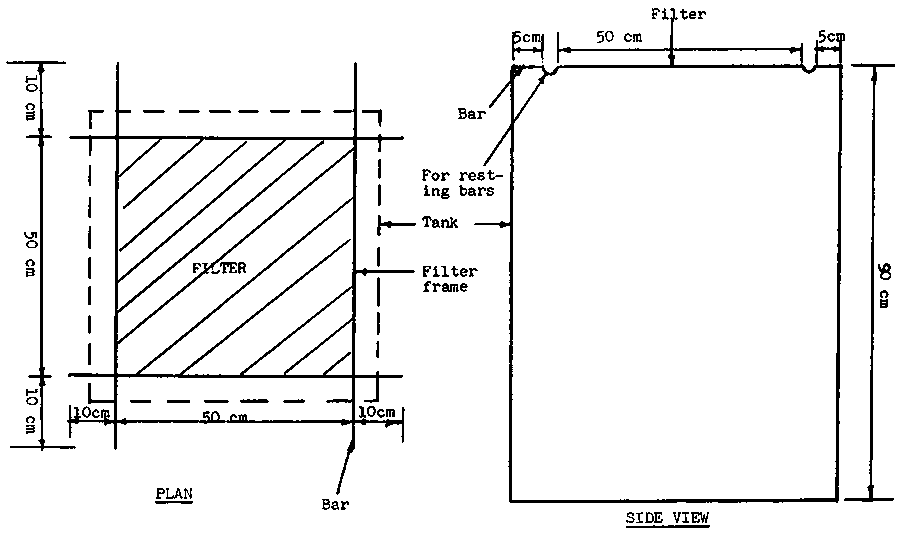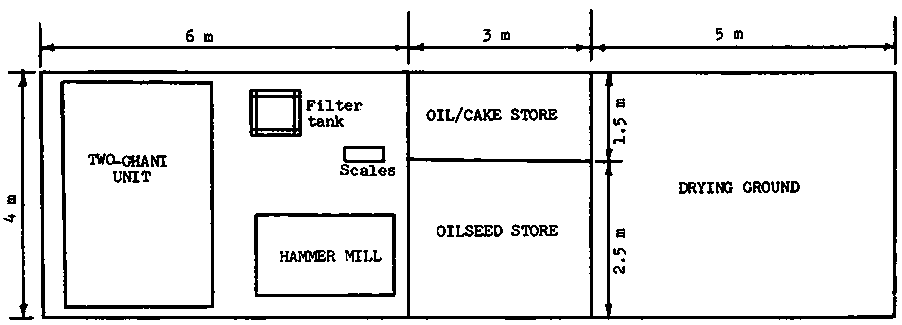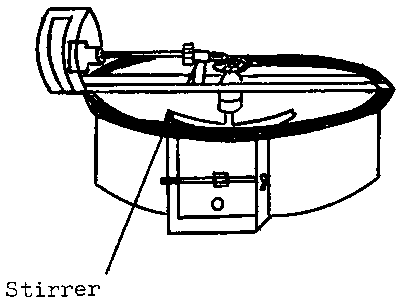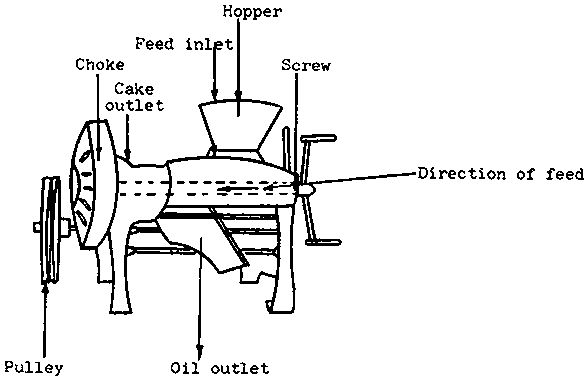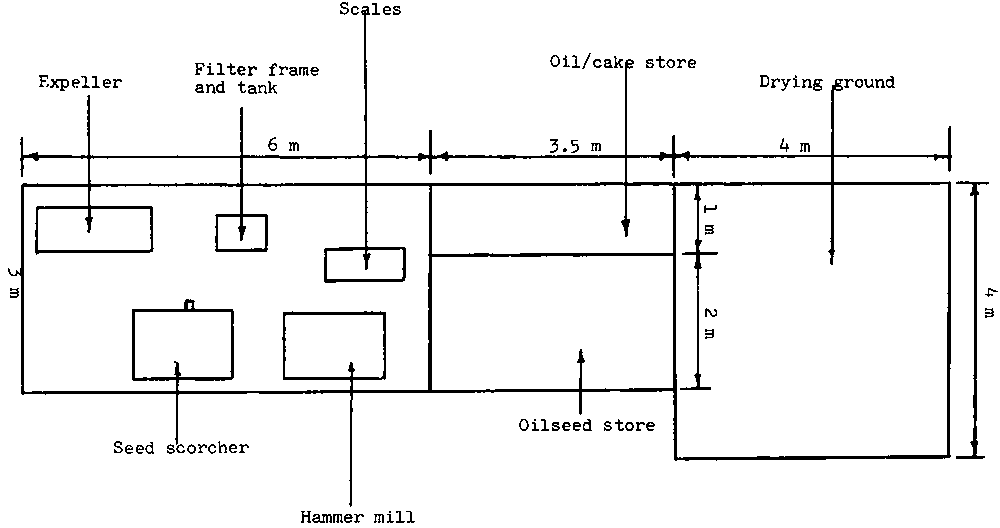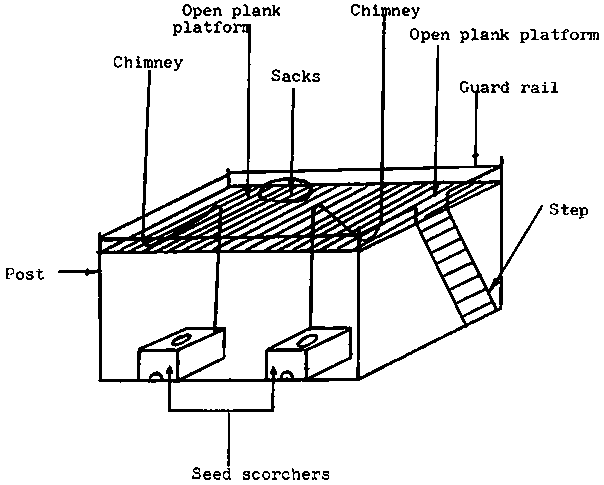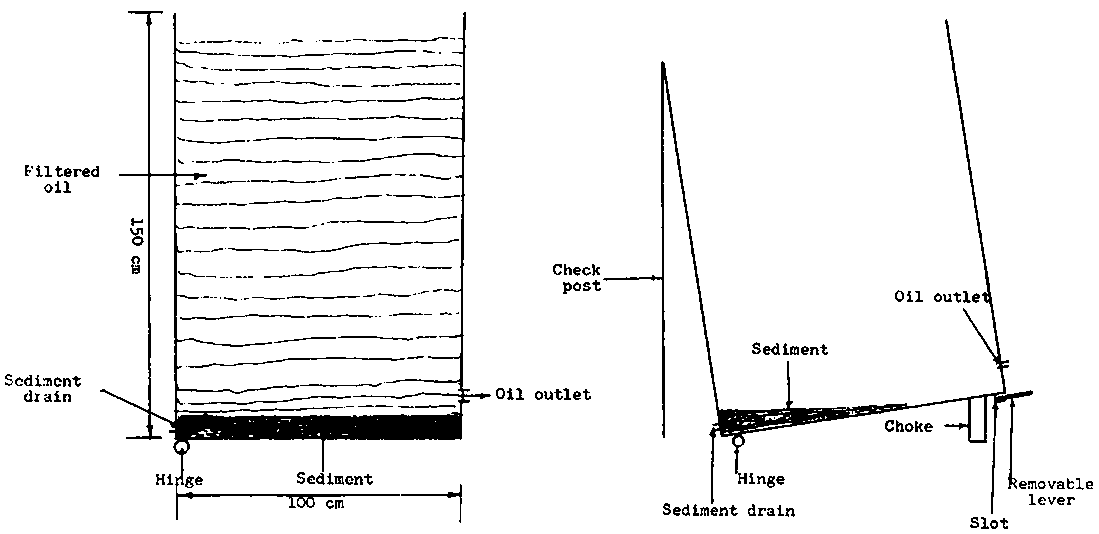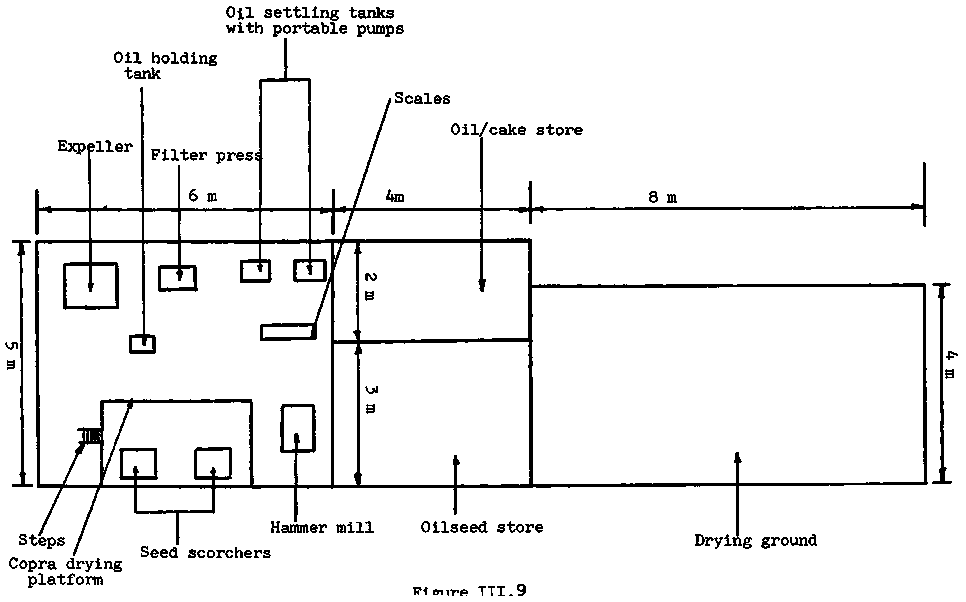Once the relevant raw materials (copra or groundnut) has been pre-processed, the next stage is oil processing. This chapter considers processing at various scales. However, given the focus of the memorandum on small-scale production, processes relevant to the latter are considered in detail. Medium and large-scale expeller mills, solvent extraction plants and wet-processing methods, which are all suited for medium and large-scale production, are therefore examined only briefly.
The overall process is the same regardless of whether the raw material used is copra or groundnuts. When differences arise due to the type of raw material used, these are explicitly mentioned at each processing stage. The major difference relates to the extraction rates which are more dependent on the raw material than on the process itself.
The three main stages of oil-processing are:
(i) Pretreatment: namely, the stages prior to the extraction stage such as cleaning, crushing and scorching.
(ii) Extraction: this stage involves the separation of the raw material into oil and residue (cake).
(iii) Post extraction treatments: comprising the packaging of the oil and cake for marketing. Oil refining, common in large-scale production, is not considered in this memorandum
The sequence of the above stages are detailed in a flow chart (see table III.1). The various processes dealt with below follow the same sequence. These stages are described for the following six types of plants: micro-plant, power ghani mill, baby expeller mill, small package expeller mill, medium and large expeller mills, solvent extraction plant and wet-processing.
TABLE III.1 - PROCESSING STAGES
III.1: Power ghani mill[edit | edit source]
The ghani mills originated from India where these indigenous oil crushers have been improved over time. The original animal-powered ghani consists of a wooden mortar and a pestle. The mortar is fixed to the ground while the pestle, attached to one or a pair of bullocks (or buffalos or camel), is rotated in the mortar where the seeds are crushed by the generated friction and pressure. The oil runs through a hole at the bottom of the mortar while the residue - or cake - is scooped out. Depending on the size of the mortar and the type of seeds, an animal-powered ghani can process 5 to 15 kg of seeds at a time. An improved version of the ghani has been developed in India. Known as the Wardha ghani, it is larger and more efficient than the traditional ghani, and can crush charges of seed of up to 15 kg in approximately 1.5 hours or close to 100 kg per day.
An engine-powered ghani is now replacing, to a large extent, the bullock-powered ghani. In this type of ghani, either or both the mortars and pestles are made of cast iron. Power ghanis are often worked in pairs. The crushing capacity of a two-ghanis unit is approximately 500 kg to 600 kg of seeds per day. Some of the technical advantages of the power ghanis, as compared to bullock-powered ghanis include a higher oil extraction rate per unit of raw materials (an increase of approximately 1-2 per cent of the extraction rate), higher output per unit of time, and the use of less space than in the case of bullock-powered ghanis, (at least two power ghanis may be set up in the space needed for a bullock-powered ghani). The quality of the oil produced by the power ghanis is identical to that produced by the bullock-powered ghanis. Power ghanis are now increasingly replacing bullock-powered ghanis in India where the number of the latter has decreased from approximately 400,000 units in the mid-1950s to approximately 230,000 units in the mid-1970s.
Improved power ghanis have an oil extraction efficiency which is fairly close to that of small-scale expellers, and often constitute a viable alternative to the latter, especially in rural areas. While this has been the case in India and in a number of Asian countries, there is no guarantee that ghani mills will meet the same approval in other developing countries. For example, the introduction of ghanis in Tanzania has met with little success. It is therefore important to analyse all the requirements for the successful adoption of ghani mills prior to investing in such units. For example, it is important to investigate whether qualified labour is available in rural areas, whether the repair and maintenance of ghanis can be carried out without much difficulty by the miller or local mechanics and whether power ghanis may be manufactured locally or must be imported.
III.1.1. Pretreatment stages[edit | edit source]
(a) Remedial drying
Remedial drying may be carried out in the open air or under a covered shed in case of adverse weather conditions. A drying ground of approximately 20 m2 will suffice (see figure III.1).
(b) Raw material storage
The amount of raw material used requires some provision for storage. To minimise losses due to fungi, insects and the weather, the following type of structures will be needed
- reflective roof
- roof overhang of walls
- controllable ventilation (shutters under the eaves)
- concrete floors for easy cleaning
- pallets or other wooden dunnage for keeping bags off floor; and
- use of fabric insecticides (10,0 gm of malathron in 5 litres of water, per 100 m2) on suspect sack material.
The size of the storage area is a function of the amount of stock necessary to ensure continuous production (e.g. stocks for one week or one month). For example, the plant lay-out in figure III.3 shows a storage area of 7.5 m2.
(c) Cleaning/inspection
Cleaning and inspection are performed manually by removing any large piece of foreign material. Chaff and sand will mostly separate out if the kernels are spread on a dry floor. The floor should preferably be made of concrete; alternatively, any dry packed surface will suffice. The raw materials should be sufficiently clean in order to avoid premature wear and tear of the equipment.
Figure III.1 - Trestle and matting arrangements over drying ground
(d) Crushing/breaking-up
Crushing can be done in a small powered hammer mill. These are available from equipment manufacturers in many developing countries. Capacity should be above 100 kg/hour, and reduction should ideally be to pieces less than 0.5 cm square.
It should be noted that pre-crushing is not traditionally used with ghani extraction. However, it is recommended, as its use improves oil yields for ghanis above those assumed in this memorandum.
(e) Scorching
This operation is omitted from the ghani process.
III.1.2. Oil extraction by pressing[edit | edit source]
The unit considered in this memorandum is a double-ghani mill, powered off a single 3 hp motor. Each ghani takes a charge of about 35 kg which is processed in approximately one hour by the rotary movement of the iron pestle in the bowl. Thus, such a unit may process up to 560 kg of seeds per day. The two ghanis may also be powered by separate engines. In this case, 2 hp motors are needed. The pestles in power ghanis rotate at approximately 10 to 12 revolutions per minute as compared to 3 to 5 revolutions for bullock-powered ghanis.
A large number of designs of powered ghanis have been developed and marketed in India. Although most of these designs are not patented, it would not be practical to provide detailed drawings of these ghanis in this memorandum. Interested readers should write for information to: Appropriate Technology Development Association, P.O. Box 311, Ghandi Bhawan, Mahatma Ghandi Road, Lucknow-226001 (India). This institution may then provide names of ghani manufacturers and/or individuals willing to provide detailed drawings of ghanis for local manufacture.
In order to facilitate oil extraction from copra it is recommended to add 1 percent of "gum accacia" to the raw materials. Thus a charge of 35 kg of copra will require 350 g of gum accacia.
III.1.3. Post-treatment stages[edit | edit source]
(a) Oil filtering
To remove small impurities, filtering may be done using an ordinary cloth stretched over a frame onto a tank of sufficient capacity (See figure III.2)
Figure III.2 - Filter frame and tank
(b) Settling
The filtered oil should be left in the tank for a few hours in order to allow the settling down of any fine impurities still suspended in the oil.
(c) Packing
The oil is transferred into tins or bottles via a funnel from a tap on the tank. The tap should be attached over the sediment layer.
(d) Oil storage (finished goods)
Storage for several days production will require only an area of a few m2.
(e) Breaking-up of cake
The cake is removed from the ghani manually. It will probably need little or no further breaking-up.
(f) Bagging
The broken up cake meal can be loaded into bags manually.
(g) Cake storage (finished goods)
A few days’ storage space, similar to but separate from the copra storage, will be necessary. Unless a prolonged period before the eventual use of cake is anticipated, insecticides are not necessary. In general, the cake will spoil rapidly after a few days, unless it is properly treated, packaged and stored. Consequently, unless an efficient cake collection system is operating in the country, the produced cake will most probably be used for animal feed within the copra processing area.
III.1.4. Ancillary stages[edit | edit source]
(a) Water
No special provision necessary
(b) Process heat
It is not essential to use heat in ghani milling. However, it is recommended to warm up the pestle towards the end of the oil extraction process.
(c) Electricity
Required to power hammer mill, ghani and ancillary services.
(d) Maintenance
The mill owner should be able to maintain the power ghanis and undertake standard repairs. If ghanis are not manufactured locally, it should be useful to either import sufficient spare parts or ensure their production by local workshops. This is a particularly important condition for an efficient running of the mill as the international marketing of ghanis (and spare parts) is not yet well developed. Ideally, developing countries wishing to promote the use of ghanis should encourage the local production of the equipment.
III.1.5. Equipment[edit | edit source]
The following equipment will be required for a plant processing 70 kg of raw material per hour and working an eight-hour day:
- movable scales, capable of weighing up to 40 kg
- 100-200 kg/hour hammer mill, with 6 mm square screen (2 hp)
- double-ghani unit, each ghani chargeable with 35 kg. of raw material per hour (motor 3 hp)
- 1 filter frame 60 cm * 60 cm with 90 cm bars
- 1 aluminium tank 80 cm * 80 cm * 110 cm
The hammer mill and ghani-unit may need to be imported. Their cost is estimated at US,000-4,000.
III.1.6. Daily requirements[edit | edit source]
The daily requirements for the mill considered above would be:
- raw material: 500-600 kg
- gum accacia: 5-6 kg for copra processing
- diesel fuel: 9 litres
- filter cloth: about two cloths per month
- tins (18 kg.): 18 tins
- electricity: approx 30 kWh.
III.1.7. Labour requirements[edit | edit source]
Two or three family members will be required for the operation of the mill. One of the workers should have the necessary qualifications for running, maintaining and repairing the ghani unit.
III.1.8. Layout of operations[edit | edit source]
The power-ghani mill is typically a family enterprise and no formal floor plan is required. However, a plan indicative of good practice is provided in figure III.3.
III.1.9. Daily output[edit | edit source]
The daily output of oil and cake are as follows:
|
320 kg of oil, |
|
213 kg of cake. | |
|
220 kg of oil, |
|
302 kg of cake. |
Figure III.3 - Plant lay-out for power-ghani mill
III.2. Baby expeller mill[edit | edit source]
The baby expeller mill considered in this memorandum has a capacity of 45 to 55 kg per hour. Therefore, by working only one day shift, which is normal for such small plants, the units can process between 350 and 450 kgs of raw material per day. In a few cases such units do work 2 or 3 shifts per day, and may then process up to one tonne of raw materials.
III.2.1. Pretreatment stages[edit | edit source]
(a) Remedial drying
Remedial drying is done as in the case of the ghani mill. The required drying area is 15m2. It should include the necessary structure in case the area must be covered to protect the raw material from the rain.
(b) Raw material storage
As in the ghani mill case.
(c) Cleaning/inspection
As in the ghani mill case.
(d) Crushing/breaking-up
This mill may use a crusher of the swing beater type with a capacity of 100 kg of materials per hour, a 2 hp power requirement, and revolving at 1,400 rpm. Copra should be reduced to pieces 6 mm square.
(e) Scorching
The oil seeds can be heated in open pans over an enclosed fire place to ensure fuel economy. The raw materials may be mechanically stirred through, for example, a linkage to the expeller or crusher drive (see figure III.4).
The length of time required is about 20-30 min. and the temperature 60-90° C. Trial and error will show the best conditions in terms of oil yield and quality.
Figure III.4 - Single open-type seed scorcher with mechanical stirrer
Cooking or scorching of oil seed is needed for three reasons; to facilitate oil extraction, to lower or increase the moisture of seed, and to reduce the wear in the screw press. The best temperature and moisture content depend on the extraction system. Copra processed through expellers should have a 2 percent to 3 percent moisture and be at approximately 60° C (higher temperatures for large-scale modern expellers). In the case of groundnuts, the temperatures attained during cooking should not exceed 120 °C as otherwise the protein quality may be adversely affected. In general, the required cooking temperature is a function of the cooking time, the type of oil extraction technology, the moisture content of the raw material and the type of seed. All these variables should be considered simultaneously when estimating the cooking temperature.
The scorching of seeds should be carried out with care in order to avoid deteriorating the copra or groundnut kernels. Over-heating or charin reduces the oil extraction rate and yields low quality oil. Since small rural processors may not afford scorching equipment with automatic control of temperature and moisture of the material, they should arrive at the right cooking conditions through learning and experience.
III.2.2. Oil extraction by pressing[edit | edit source]
Pressing can be achieved by either a single, duo, or duplex expeller. Their drive can be provided by either an electric motor, or via a pulley and v-belt from a separate diesel engine. Small capacity expellers are produced by various specialist manufacturers, notably in Japan and India.
Operations and precise capacities vary from machine to machine. However, the following basic variants occur:
(i) a single expeller capable of producing the assumed oil yield in a single pass. An example of such an expeller is shown in figure III.5 It has the following characteristics:
- capacity: 45-55 kg per hour
- power requirement: 3 hp
- 300 rpm;
(ii) A single expeller of lower pressure but higher first-pass capacity. The scorched seed is fed through once at lower pressure (choke fairly wide open) and the press cake is then re-fed through the expeller at a higher pressure (choke narrowed). Most of the oil is extracted in the first pass, but a significant additional amount is yielded by the second pass. Obviously, the expeller must be capable of completing the processing of the daily input in this two-pass manner. Therefore, the capacities of each of the single passes must be higher than the daily input.
(iii) A dual expeller combining a first-pass low pressure expeller and a second pass high pressure expeller. In this case the cake from the first expeller is fed automatically to the second;
(iv) A duplex expeller employing screws of varying pitch and differently shaped barrel areas. This arrangement increases the pressure as the material is forced through the barrel. Duplex units achieve higher yields and faster throughput in a single operation. They are recommended if the right capacity machine is available.
Figure III.5 - Sketch of a low-pressure expeller (2 hp)
When using a single expeller, the decision on whether to pass the oil seed once or twice should be based on economic considerations. A second pressing raises the oil extraction rate, and therefore yields additional revenues, but also increases processing costs. Thus, a second pressing will be justified in the only case where the increase in revenues is at least equal to the increase in cost. In general, given the relatively low extraction rate of small expellers, small rural mills in developing countries find it profitable to press the raw materials twice, the first time at low pressures - and therefore high hourly output - and the second time at higher pressures through an adjustment of the choke.
The extraction of groundnut oil in small expellers is a highly skilled job as it is necessary to add groundnut shells to the kernels in order to prevent the forming of peanut butter. The adding of shells is necessary because groundnut kernels, unlike copra, have little fibre. The need for skilled labour should therefore be taken into consideration when choosing among various types of expellers.
When ordering the equipment, the mill operator should specify the type of raw materials to be processed as the spacing between the bars (which are part of the expeller barrel) is a function of the type of oil seed. For example, the spacing of the bars in the feed and centre sections of the expeller are approximately three times wider for copra than for cotton seed.
Expellers require periodic maintenance and repairs, the principal wearing pieces being the liner bars, the worms and the distance pieces. The periodicity of maintenance and repairs is a function of the rate at which the above piece of equipment is worn out by the abrasive action of the raw materials and that of foreign matter (e.g. sand, pieces of iron). The abrasive action of foreign matter is particularly harmful and can considerably shorten the life of various parts of expellers.
Line bars suffer less than other parts of the expeller, but cannot be repaired: they must be replaced by new bars. On the other hand, worms and distance pieces can be welded and re-used. In general, worms may work eight to ten weeks before repairs are needed, depending on the type of expeller. However, foreign matter may shorten the above period to two weeks or less. It is therefore essential that the raw materials be as clean as feasible under the prevailing processing conditions.
Mill operators should learn to carry out basic repair and maintenance of expellers or be able to secure the services of a nearby specialised mechanic. They should also have available a stock of parts if the latter are not manufactured locally and may not be obtained as soon as they are needed. It is essential that repair and maintenance of expellers can be carried out quickly if one is to avoid high processing costs (i.e. through an increase of depreciation costs resulting from a lower utilisation rate of the expeller).
The choice of expeller is a difficult one to make as the mill owner should consider both the current scale of production as well as an eventual expansion of the mill. Although no precise advice may be given without knowing the exact circumstances under which a mill is being established, a general rule for small rural mills is to start with a relatively cheap expeller which may process, in one or two passes, the daily input of raw materials. As suggested earlier, the decision regarding a second pass of the cake should be based on a comparison of additional revenues and costs. The lay-out of the mill should, however, be such as to allow the use of a second expeller if an expansion of capacity is being considered. The prime mover of the expeller should also be suitable for the second expeller. The latter may have a higher capacity than the first one in order to ensure greater flexibility in the mill operation.
III.2.3. Post-treatment stages[edit | edit source]
(a) Filtering (oil):As in the case of the ghani mill. Alternatively, and whenever it is economically feasible, the mill may use a small chamber filter press with ten plates of 18 * 18 cm, with attached oil pump. The pump makes 170 rpm and has a power requirement of 0.5 hp. Such a press may process up to 50 litres per hour, and should therefore be sufficient for the filtering of the daily output of oil. Filtration takes place through paper and filter cloth.
(b) Settling: As in the case of the ghani mill.
(c) Packing: As in the case of the ghani mill.
(d) Oil storage.: As in the case of the ghani mill.
(e) Breaking-up of cake, bagging and cake storage: As in the case of the ghani mill.
III.2.4. Ancillary stages[edit | edit source]
(a) Water
No special provision necessary.
(b) Process heat
The amount of process heat depends on the adopted scorching technique.
(c) Electricity
Requirements for expeller drive.
(d) Maintenance
The mill owner should be familiar with the maintenance and repair of expellers and should have sufficient spare parts on order to avoid long shut-downs of the mill. The type of repairs which may be needed have already been described earlier in this section.
III.2.5. Equipment[edit | edit source]
The following equipment will be needed for a plant processing 400 kg of raw material per eight-hour working day:
- movable scales, capable of weighing up to 80 kg
- one seed crusher of the swing-beater type, 2 hp, 1400 rpm
- one seed scorching pan, 100 cm diameter * 15 cm deep, with a mechanically driven stirrer.
- one expeller unit, power driven, with a processing capacity of 50 kg of raw material per hour (3 hp). It should produce cake with an oil content of 7.5 to 8 per cent
- one filter frame, 60 * 60 cm, with 90 cm bars
- one aluminium tank 80 * 80 * 110 cm.
The total cost of the equipment which may need to be imported is estimated at US,000.
III.2.6. Daily requirements[edit | edit source]
The daily requirements for a plant similar to the one considered above will be:-
- raw materials: 400 kg
- diesel fuel: 9 litres
- electricity (if no diesel fuel is used): 30 kWh
- wood or other local fuel: 30 kg
- tins (18 kg): 14
- filter cloths: three every two months.
III.2.7. Labour requirements[edit | edit source]
Two or three family members should suffice for the running of the unit. The mill owner should have the necessary skills for the running of the equipment, as well as for maintaining and repairing the latter.
III.2.8. Layout of operations[edit | edit source]
This scale is typically a family enterprise. Therefore the floor plan in figure III.6 is only indicative of good practice.
III.2.9. Daily output[edit | edit source]
The daily output of oil and cake are as follows:
|
245 kg of oil, |
|
135 kg of cake. | |
|
165 kg of oil, |
|
215 kg of cake. |
Figure III.6 - Plant lay-out for a baby expeller mill
III.3. Small package expeller mill[edit | edit source]
The capacity of this mill is the double of that of the baby expeller mill (800 kg/day). Therefore, certain modifications to the process described above are required for this type of mill. The capacity of this mill may be increased to 2.4 tonnes per day on a three-shift basis. This will require an extension of the storage areas for raw materials and output.
III.3.1. Pretreatment stages[edit | edit source]
(a) Remedial drying
The method described in the previous plants may still be adequate. It may also be possible to employ a simple form of in-sack artificial drying by building a platform above the seed scorchers (see figure III.7).
(b) Raw material storage: As in previous plants. Sufficient space should be allowed for the storage of one week’s input of raw materials (e.g. 4 tonnes).
(c) Cleaning/inspection: As in previous plants.
(d) Crushing/breaking-up
As in the previous plants. The crusher capacity should be scaled up to allow a fast completion of the operation, thus freeing labour for other operations.
(e) Scorching
As in the case of the baby expeller. Two scorcher units are used side-by-side at this scale.
III.3.2. Oil extraction by pressing[edit | edit source]
A motor-driven expeller capable of processing 120-140 kg/hour of raw material is required. A duplex unit is most suitable for this purpose. If a single expeller were to be used, it should have a power requirement of 5 hp and run at 350 rpm.
Figure III.7 - Copra drying platform over scorchers
Note: Planks are 4 cm wide and 15 cm apart
III.3.3. Post-treatment stages[edit | edit source]
(a) Filtering (oil)
The oil is passed through the expeller screen into a small holding tank from where it is pumped mechanically through a small chamber filter press. A filter press twice the capacity of Chat described in the case of the baby expeller should be adequate. The residue which accumulates on the cloth undergoes a second passage through the expeller.
(b) Settling
After the filtering, it is best to leave the filtered oil to settle for a couple of days. Two separate tanks are used for this purpose. Provision should be made for periodic draining of sediment through taps at the bottom of the tanks. The latter should be inclinable to facilitate this operation (see figure III.8).
(c) Packing
At this scale, the same operation as used in plant 2 is adequate. However, a small foot-operated or motorised pump would facilitate this operation.
(d) Oil storage
The plant is unlikely to store more than a few days production as distribution is likely to be largely local. However, some of the oil may be marketed more widely, and sufficiently large storage capacity may be required.
(e) Cake breaking-up: As in the case of the baby expeller.
(f) Bagging: As in the case of the baby expeller.
(g) Cake storage: As in the case of the baby expeller.
III.3.4. Ancillary stages[edit | edit source]
(a) Water
No special provision necessary unless the adopted expeller is water-cooled.
(b) Electricity
Electricity is required to operate the equipment.
(c) Maintenance
As in previous plants. At least one operator should be skilled in small mechanical repairs to reduce expenses.
Figure III.8 - Inclinable settling tank for sedimentation drainage
III.3.5. Equipment[edit | edit source]
The following equipment will be needed for a plant processing 800 kg of raw material per eight-hour working day:
- movable scales, capable of weighing up to 80 kg
- drying platform over seed scorchers, if desired
- one 200-400 kg/hr crusher mill with a 6 mm square screen (4 hp)
- two seed scorching pans, 100 cm diameter * 15 cm deep with mechanically driven stirrer (drive run off crusher mill power by v-belt and pulley)
- one duplex expeller unit, with an input capacity of 100 kg/hour(6 hp). The oil content in the cake should be 5-6 per cent. Alternatively, a 5 hp expeller may also be adequate
- one oil holding tank 75 * 75 * 90 cm
- one champer filter press with 12 plates 25 * 25 cm to filter up to 100 or more litres/hour (this allows room for expansion of expeller capacity), with attached oil pump
- two aluminium settling tanks, 100 * 100 * 120 cm (capable of holding together up Co two day’s oil output), with oil outlets and sediment drainage
- one small pump with plastic hose for pumping filtered oil into tins.
The total cost of equipment which may need to be imported is estimated at US,000.
III.3.6. Daily requirements[edit | edit source]
The daily requirements for a plant like the one considered above would be:
- raw materials: 800 kg
- electricity: 75 kWh
- wood or other local fuel: 60 kg
- filter cloths: 5 per 2 months
- tins (18 kg): 28.
III.3.7. Labour requirements[edit | edit source]
Three workers. One should be skilled in simple maintenance and repair tasks, especially the repair of the worms and bars.
III.3.8. Layout of operations[edit | edit source]
The floor plan in figure III.9 is indicative of good practice. If desired, the layout may be spaced out to allow for expansion of capacity.
Figure III.9 - Plant lay-out for a small package expeller mill
III.4. Medium and large expeller mills, solvent extraction plants and wet-processing plants[edit | edit source]
Both medium and large expeller mills follow the same stages of oil processing as the three plants considered above. As is to be expected, their scales involve the use of larger and more sophisticated equipment. Technical details on these mills are not provided in this memorandum since the latter is to focus essentially on small-scale oil extraction units.
III.4.1. Medium expeller mills[edit | edit source]
The lowest economical capacity for a medium-sized oil mill, working one day shift, is three-and-a-half tonnes, i.e. 1,000 tonnes per year. However, it is fairly normal for this type of plant to operate on three shifts per day and Co process eight to ten tonnes per day, or 2,400 to 3,000 tonnes per year. The upper limit is about 20 tonnes per day, i.e. 6,000 tonnes per year.
Some pieces of equipment not used at small scales of production are needed at these larger scales. They include seed cleaners, a separate screening tank, an air compressor for the filter press and conveyors for the mechanical transport of various materials including the expeller cakes. A list of equipment needed for a 20 tonnes per day coconut oil extraction plant is shown in table III.2. This list is taken from the following UNIDO publication:
UNIDO: Coconut Processing Technology Information Documents,
Part 2 of 7, Coconut oil extraction (Vienna, 1980), limited distribution.
The above publication focuses on medium to large-scale oil processing plants, providing detailed technical information on nine different oil extraction units ranging from a full-press mechanical extraction plant of 4 tonnes copra/day to a full solvent extraction plant of 150 tonnes/day. A 250 tonnes copra/day wet-coconut processing plant is also described in this publication.
Table III.2
List of equipment for a 20 Tonnes/day copra processing plant
|
2 - |
Platform scales, beam-type, capacity 500 kg, 0.1 kg accuracy for weighing copra in sacks. |
|
1 - |
Copra bin, 20 metric tons capacity in three compartments, mild steel construction, with bottom conveyor. |
|
1 - |
Copra pre-crusher, horizontal, low-speed hammer mill; capacity 1 ton/hr; with hopper, 10 hp motor drive. |
|
2 - |
Copra grinder, high-speed peg mill, horizontal shaft, with 100 cu ft hopper, screen feeder, each with 15 hp motor drive; capacity 1 ton/hr each. Used alternately. |
|
1 - |
Roller mill, 3-high, with 3 sets of 10" * 3" rollers, 100 cu ft hopper and 7.5 hp motor drive; capacity 1 ton/hr. |
|
2 - |
Expellers, single worm, 4-high croker-conditioner, vertical feeder, distribution conveyor, overflow bin, return conveyor, each with 25 hp motor drive; capacity 500 kg/hr each. |
|
1 - |
Screening and settling tank, 20-mesh stationary screen on top of the tank, 100 cu ft. tank with conical bottom, foots withdrawal bottom valve; mild steel construction. |
|
1 - |
Filtering pump, centrifugal, 60 psi, capacity 15 gpm, cast-iron casing, cast-iron impeller, graphited asbestos packing, open-impeller type, with 2 hp motor drive. |
|
1 - |
Plate-and-Frame Filter Press, flushed-plate type, open delivery, 24" * 24" with 30 plates and 29 frames, with oil trough, and cake pan. |
|
1 - |
Crude oil storage tank, 100 tons capacity, cylindrical with conical top, depth gauge, mild steel construction. |
|
1 - |
Cake grinder, made of ribbon type screw conveyor with rod breakers, 3 hp motor drive. |
|
1 - |
Meal bin, cylindrical with conical bottom discharge gate, capacity 5 metric Tons of cake, mild steel material. |
|
1 - |
Platform scale for weighing cake in bags, capacity 500 kg, beam-type, 0.1 kg accuracy. |
|
1 - |
Platform scale for weighing coconut oil in 55-gal drums beam-type; capacity 500 kg. |
|
1 - |
Set of conveyors: inclined screw conveyor from bodega to copra bin, transfer screw conveyor from bin to crusher, rotor-lift from crusher to grinder, rotor-lift from grinder to roller, horizontal screw conveyor and rotor-lift from roller to cooker. |
|
1 - |
Oil transfer pump for pumping oil from filter to storage tank, centrifugal type, 60 psi, CI casing and impeller; capacity 15 gpm; with 2 hp motor drive. |
|
1 - |
Oil transfer pump for pumping oil out of storage tank, capacity 30 gpm, centrifugal, CI material, with 3 hp motor. |
|
1 - |
Set of drum-closing tools to seal 55-gal steel drums. |
Source: UNIDO (1980), op.cit.
The daily requirements, including labour, for a medium expeller mill are given in Chapter IV.
III.4.2. Large expeller mills[edit | edit source]
Large expeller mills are larger versions of the medium expeller mills considered above. The lower economic level for such plants is 22 tonnes of raw material processed per 24 hours. The use of three duo super expellers could raise the production level to nearly 100 tonnes of raw material processed per 24 hours (three shifts)
The equipment for a plant operating at this scale would include large expellers, the equipment mentioned in connection with medium expellers (suitably scaled up) and new features such as automatic scales, a separate cooker dryer and oil cooling of the expeller
Daily requirements, including labour, for a plant at this scale are given in Chapter IV.
III.4.3. Solvent extraction plants[edit | edit source]
Even the most perfect expellers leave at least six percent of oil in the expeller cake. The above rate is normally exceeded in most expellers. It is possible to recover these losses using a solvent extraction plant. Such a plant can reduce the residual oil in cake to less than 1 percent although it is good practice to maintain a 2 percent oil in cake. However, a major drawback of this process, especially in view of the bias of this memorandum towards small-scale production, is that it is by nature suited Co large scale extraction. The range of production levels employed in solvent extraction plants is between 50 to 200 tonnes per day. Other drawbacks include the high investment costs, the need for highly skilled labour, low employment generation and danger of explosions if the plant is not kept in perfect condition. While solvent extraction plants may not constitute a viable rural industry, a number of these plants (depending on the national volume of oil seeds processed each year) may be profitably established for the processing of both oil seeds and the cake produced by small oil extraction units. This will, however, require a good cake collection system and a sufficient supply of oil seeds in order to maintain the solvent extraction plants running at sufficiently high capacity utilisation rates.
There are two main groups of solvent extraction plants:
- batch extraction
- continuous extraction.
Common to all extraction plants is their minimal need of operators for supervision. However, the operators that are needed require long and careful training.
III.4.4. Wet-processing (for copra only)[edit | edit source]
The technique of wet-processing involves the mechanical conversion of fresh coconut meat into a milky water-based emulsion which is separated into oil and protein by centrifugation. If a solid protein product is desired, a further drying stage is necessary.
The motivation for wet-processing is the recovery of protein contained in copra. The latter tends to be denatured by the conventional process of copra milling. Furthermore, the traditional copra milling process entails losses of oil from spoilage during the copra drying stage, from insect or rodent attack during the copra storage stage, or from incomplete extraction of oil by mechanical as opposed to chemical means of oil extraction. Obviously, these losses can be minimised if processing is undertaken with care.
Wet-processing has many drawbacks. Its major drawback, from the point of view of this memorandum, is the fact Chat they are not economically feasible at small scales of production. In addition, wet processes entail a loss of oil which is rarely lower than 10 per cent. Another drawback is that the process involves the use of fresh coconut meat. This normally implies higher transport costs than those involved in copra milling.
